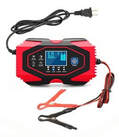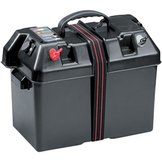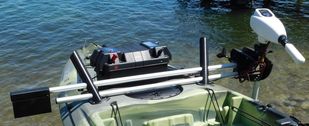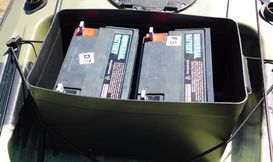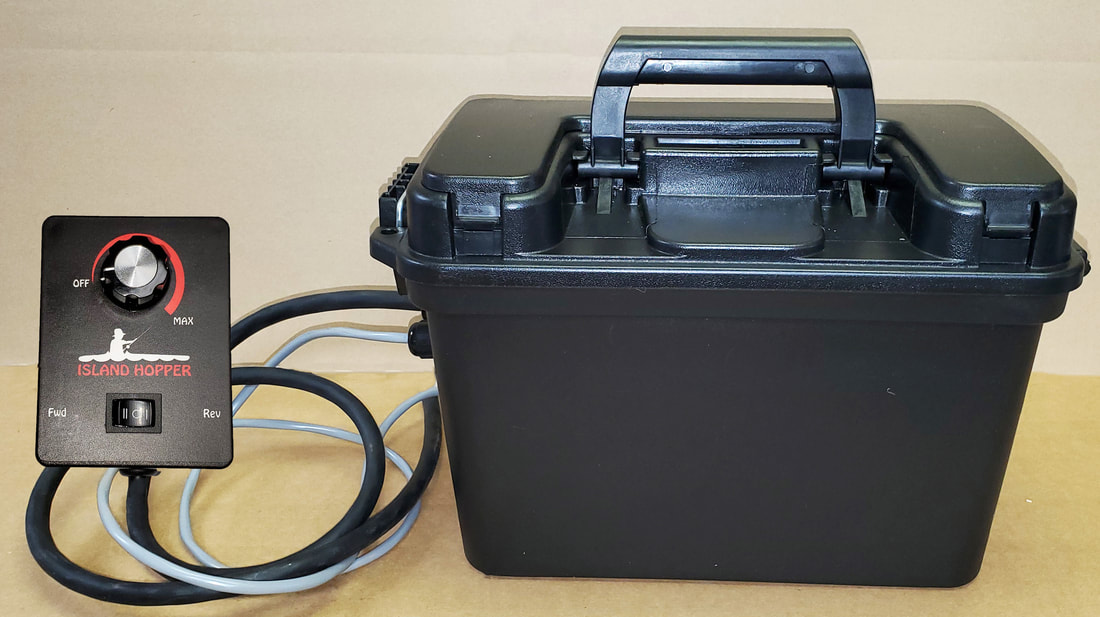Batteries & Chargers
Best Batteries for Kayak Motor, LifePo4, Battery Box
|
AGM Battery 35ah/12volt Sealed Item # 83699
This is based on a 30 lb. thrust trolling motor: 4 hours at 1st / 2nd speed, 3 hours at 3rd speed, 1.25 hours at 5th speed. Times will be shorter with higher thrust power. Approx. size: 9" x 8" x 6" (may vary slightly by 1" on all side) For more information, see information below. Trolling motors require a 12v battery to operate. Depending on the pounds of thrust of the motor you choose, you may require a back up battery for longer range use.
Battery range will vary due to size, weight and type of kayak in addition to kayaks load, wind and current. |
Item # 83699
Sale Price $99.99 |
Combo Package - Charger / 12volt & AGM Battery 35ah/12v
|
Battery Charger with a 35ah AGM Sealed Battery Item # 88-4324
35ah / 12volt 4 hours at 1st / 2nd speed 3 hours at 3rd speed 1.25 hours at 5th speed Based on a 30 lb Thrust Trolling Motor. Times will be shorter with higher thrust power. For more information, see information below. |
Item # 88-4324
Sale Price $154.99 |
|
|
Lithium Ion Battery and Charger Item # 83644
LiFePO4 12V 60Ah Lithium Iron Phosphate Battery Pack, Light Weight LiFePO4 Battery for kayak trolling motors. The highest quality lithium iron Phosphate technology. In most standard 12 volt systems the best choice of lithium battery is LiFePO4 (lithium Iron Phosphate). The voltage of this type of battery is very similar to an AGM. Super lightweight, 15 lbs. +/-, delivers approx. 120amps. Includes lithium ion charger. Application: Boats/Kayaks/Marine: LiFePO4 batteries offer tremendous advantages for powering small boats and kayak motors, and other electronic needs. Designed and programmed for Island Hopper Trolling Motors. |
Item # 83644
Sale Price $549.99 |
|
Carry Battery Box Case for 60a Lithium-Ion Battery - Wired
Item #33-9090-LITH-BOX This carry battery box case fits an Island Hopper 60ah Lithium-Ion battery. Carry Box comes completed wired and Plug & Play ready when purchased along with our 60ah lithium-ion battery. The trolling motors remote controller plugs directly into the carry battery box allowing the lithium ion battery to stay safe and free from water splashing. Features easy-access external battery terminals that allow trolling motor leads and charger leads to be connected without opening the box. Includes battery box with handle and wiring cables. Does not include battery or remote control. |
Item # 33-9090-LITH-BOX
Sale Price $124.99 |
Charger Information
Microprocessor technology gives this 12-volt battery charger the power to charge 12v batteries such as: AGM, GEL, SLR, and Deep Cycle Marine batteries. Built in automatic microprocessor control adjusts the amperage rate to charge and maintain batteries quickly and safely.
Battery charger allows reading stored energy in battery prior to charging your battery just like a multimeter, without the need to plug charger.
Choose different modes for specific batteries to be charged and smart battery charger will deliver the amperage needed.
The high frequency current pulse, “Repair Mode” can be used to recondition car batteries that are weak, sulfated or deeply drained. This function is programmed in the microprocessor chip to repair an old battery as long as the battery has some life left in it.
The smart battery charger technology will process your battery condition by ramping seven charging rates using its, ”Pulse Width Modulator”, as well as to conserve energy while charging.
Microprocessor control adjusts current to match battery type and condition.
Battery charger will charge 12-volt conventional batteries at a rate of 8 amps per hour, and 24-volt batteries at a rate of 4 amps per hour.
Charger Application
There are many brands of kayak battery chargers on the market: inexpensive and expensive. We noticed after completing a charge, they often displayed a numerical number, a green light, or an arrow needle pointing to a full charge. Fact, a battery will start up a car, boat, plane, tractor etc., with a 75% charge, which is ample to start any of the above and will display or register 12 volts. However, for kayak use, one needs to know precisely how much "juice" is in the battery, since every amp counts.
Test Comparison
A 12 volt/75ah deep cycle battery was charged with a basic battery charge, after three hours the basic battery charger indicated a full charge. When retested with the smart battery charger, the read-out was at 80% charged. The battery required an additional 2½ hours of charging to reach a true 100% full charge. To a kayaker, this means if they were fishing, they would only have about 3 hours of battery time, instead of the 5 to 6 hours with a true 100% charged battery.
Conclusion
The battery chargers recommend above delivered the best performance for the money.
AGM Battery Information
AGM Battery Advantages
AGM Battery Disadvantages
Deep Cycle Battery
A deep-cycle battery is designed to discharge between 50% and 80% depending on the manufacturer and construction of the battery. Although these batteries can be cycled down to 20% charge, the best lifespan vs cost method is to keep the average cycle at about 50% discharge.
Microprocessor technology gives this 12-volt battery charger the power to charge 12v batteries such as: AGM, GEL, SLR, and Deep Cycle Marine batteries. Built in automatic microprocessor control adjusts the amperage rate to charge and maintain batteries quickly and safely.
Battery charger allows reading stored energy in battery prior to charging your battery just like a multimeter, without the need to plug charger.
Choose different modes for specific batteries to be charged and smart battery charger will deliver the amperage needed.
The high frequency current pulse, “Repair Mode” can be used to recondition car batteries that are weak, sulfated or deeply drained. This function is programmed in the microprocessor chip to repair an old battery as long as the battery has some life left in it.
The smart battery charger technology will process your battery condition by ramping seven charging rates using its, ”Pulse Width Modulator”, as well as to conserve energy while charging.
Microprocessor control adjusts current to match battery type and condition.
- Large easy-to-read LCD display shows full range of readouts including voltage/amperage, charge capacity and includes "bad battery" indicator.
- Automatically switches to maintenance mode when battery is charged.
- FUL is displayed when battery is full charged.
- Built in cooling fan to keep charger electronics cool while charging battery and extend battery charger life.
Battery charger will charge 12-volt conventional batteries at a rate of 8 amps per hour, and 24-volt batteries at a rate of 4 amps per hour.
Charger Application
There are many brands of kayak battery chargers on the market: inexpensive and expensive. We noticed after completing a charge, they often displayed a numerical number, a green light, or an arrow needle pointing to a full charge. Fact, a battery will start up a car, boat, plane, tractor etc., with a 75% charge, which is ample to start any of the above and will display or register 12 volts. However, for kayak use, one needs to know precisely how much "juice" is in the battery, since every amp counts.
Test Comparison
A 12 volt/75ah deep cycle battery was charged with a basic battery charge, after three hours the basic battery charger indicated a full charge. When retested with the smart battery charger, the read-out was at 80% charged. The battery required an additional 2½ hours of charging to reach a true 100% full charge. To a kayaker, this means if they were fishing, they would only have about 3 hours of battery time, instead of the 5 to 6 hours with a true 100% charged battery.
Conclusion
The battery chargers recommend above delivered the best performance for the money.
AGM Battery Information
AGM Battery Advantages
- All AGM batteries have enhancements over flooded lead acid batteries
- Fluid retention - un-spillable
- High on power density, holding roughly 1.5 x the AH capacity of flooded batteries due to purer lead
- Low internal resistance allowing them to be charged quite rapidly
- Water conservation - never requires addition of water
- Acid encapsulation in the matting
- Availability of UL, DOT, CE, Coast Guard, and Mil-Spec approved
- Vibration resistance due to the sandwich construction
- AGM store very well and do not sulfate or degrade as a deep cycle batteries
- AGM batteries can be stored anywhere, side ways, upside down in part that they are "sealed regulated valve", therefore, no leakage
- AGM batteries weigh a third less than the weight of a deep cycle.
- Compare our AGM 35ah at 23lbs vs 37lbs lead acid deep cycle.
AGM Battery Disadvantages
- AGM batteries cost 20% more than deep cycle batteries.
- AGM batteries have up to a 10 year lifespan, but must be sized to discharge less deeply than the traditional flooded batteries.
- AGM batteries do not tolerate overcharging. Overcharging dissociates the water in the electrolyte, which is unable to be replaced, leading to premature failure.
Deep Cycle Battery
- Deep Cycle batteries have less instant energy, but greater long-term energy delivery.
- Deep Cycle batteries cost less than AGM, have thicker plates and can survive numerous discharge cycles and are heavy approx. 37 lbs.
- Deep Cycle batteries tend to sulfate or degrade and can only be stored upright to avoid acid spillage.
- Deep Cycle batteries often used on Kayaks are 75 ah and weight 42 lbs.
A deep-cycle battery is designed to discharge between 50% and 80% depending on the manufacturer and construction of the battery. Although these batteries can be cycled down to 20% charge, the best lifespan vs cost method is to keep the average cycle at about 50% discharge.


